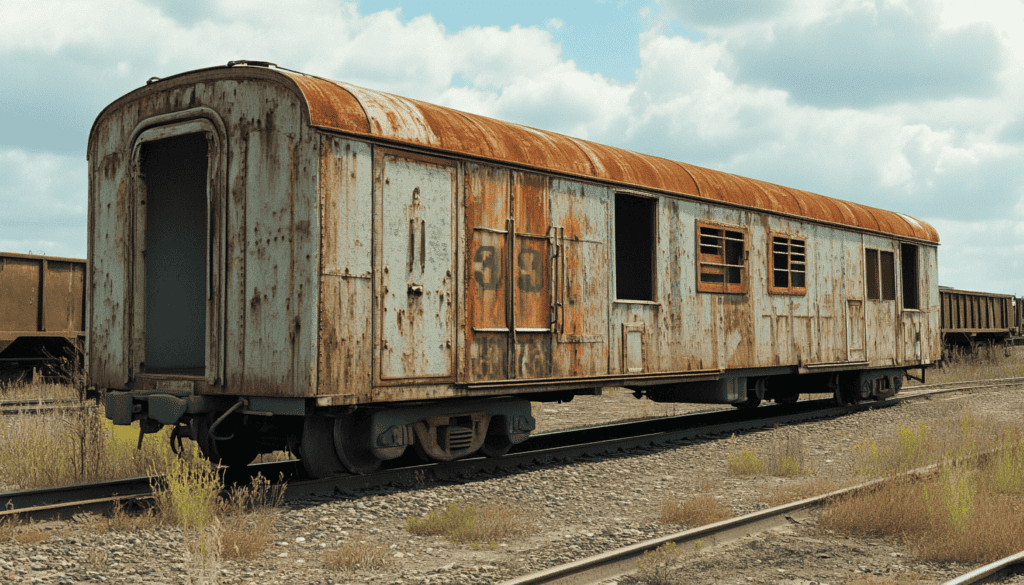Table of Contents
refrigerated railcar
Key Highlights
- The advent of refrigerated railcars revolutionized the transportation of perishable goods, particularly fresh meat.
- The meatpacking industry experienced a significant transformation, shifting from local to national distribution.
- Refrigerated railcars enabled the expansion of fresh produce markets, allowing perishable goods to be transported long distances.
- The invention facilitated the growth of major cities by ensuring a consistent food supply.
- The impact of refrigerated railcars extended beyond the food industry, influencing farming practices and boosting the economy of rural areas.
Introduction
The refrigerated railcar came into use in the late 1800s. This was a major change in transportation and greatly affected many businesses. One of these was the meatpacking industry. It changed from local sales to a national business. This new railcar made it easier to move perishable goods over long distances. This changed how food was shared and consumed throughout the United States.
The Impact of Refrigerated Railcars on the Food Industry

Before refrigerated railcars, moving perishable goods, especially fresh meat, was hard because of distance. Meatpacking was mainly a local business. People usually ate meat close to where animals were slaughtered. Meat often spoiled during transport, creating a big problem. This issue stopped the industry from growing and made it hard for consumers to get fresh food.
But when refrigerated railcars came along, it made a big difference. Now, fresh meat and other perishable goods could travel long distances. This change changed the food industry a lot. It removed distance issues and changed how food was made, sold, and eaten.
How Refrigerated Railcars Revolutionized Meat Transport
Before refrigerated railcars were invented, fresh meat was a special treat. Moving it over long distances was hard because it spoiled quickly. This meant meatpacking could only serve local markets, and people had to rely on salted or smoked meat to keep it fresh.
In the 1870s, the refrigerated railcar changed everything. These railcars had ice-cooled sections that let fresh meat be transported far away without going bad. This new way of moving meat turned meatpacking from a local business into a national one.
Now, meatpackers in Chicago and Kansas City could sell their products to people on the East Coast. This opened up a huge market. With fresh meat being transported easily, demand grew, prices dropped, and more people had access to fresh meat in their diets.
The Expansion of Fresh Produce Markets Across the United States
The use of refrigerated railcars changed how perishable goods were moved. It was not just about meat anymore. Now, fruits, vegetables, and dairy products could travel many miles to major cities. People could get a greater variety of fresh foods all year long. This changed how consumers bought and ate their food across the country.
Farmers, especially in the Midwest, gained a lot from this new way to reach markets.
- They could sell their crops to big cities far away, pushing them to grow more and focus on special crops.
- This helped farms grow and improved the economy in rural areas that were once held back by where they were located.
- Moving fresh produce over long distances also brought people together, creating shared food experiences throughout the United States.
Revolutionizing the Meatpacking Industry

The 1870s brought big changes to the meatpacking industry. Refrigerated railcars changed everything. They allowed meatpackers to reach further and work on a much larger scale. Cities like Chicago and Kansas City became busy centers for meat processing and shipping, sending many meat products across the nation.
This growth made things more efficient and lowered the costs of production. Because of this, meat became more affordable for regular people. Bigger meatpacking companies also created jobs and helped the economy in the areas where they were located.
Now, consumers could get fresh meat over long distances. This made fresh meat a regular part of the American diet instead of just a luxury. The meatpacking industry, once small and local, grew into a major player, changing American agriculture and the way people consumed food.
Changing the Landscape of Textile Production
The refrigerated railcar is mainly known for changing the food industry. However, its effects reached other areas too, even if not in a direct way. For example, the textile industry didn’t use refrigerated railcars to move goods directly. Still, it gained from the new ideas and technologies that came from their needs.
The requirement to keep steady temperatures in railcars is key for saving perishable goods. This led to better insulation and temperature control technology. These new technologies were then used in textile mills. In production, keeping the right temperature and humidity is very important. The improved insulation methods made for refrigerated railcars helped to control temperatures in textile factories. This resulted in better efficiency and quality of the products.
Also, the success of transporting goods over long distances with refrigerated railcars inspired new ideas in textile shipping. This made it easier to move raw materials and finished textile products, helping the growth of the industry.
Transforming Farming Practices
The refrigerated railcar changed farming in a big way, especially in the Midwest. Before it was invented, farmers only grew crops that would not spoil or could be eaten or made into products nearby. Now, they could ship perishable goods to faraway places. This opened new markets for farmers.
The Midwest had rich soil and was ready to take advantage of this change. Farmers began to grow more perishable and profitable crops like fruits, vegetables, and dairy. These crops could now be sent to large cities. This change made farmers use land that they once did not want to use because they worried about spoilage.
Because of the refrigerated railcar, special areas for farming started to develop. The Midwest became a major source of fresh produce for the rest of the country. This helped the rural economy grow and changed farming in the area for many years.
Boosting the Economy of Rural Areas

The refrigerated railcar was very important for boosting the economies of rural areas. It allowed farmers to transport perishable goods. This connected farming communities to distant markets. As a result, farmers could sell to more customers, which meant more sales and bigger profits.
This increase in farm income helped local economies. With more money, people in rural areas wanted more goods and services. This supported local shops and businesses. Also, the growth of agricultural industries due to refrigerated railcars led to the creation of new jobs in farming, processing, and transportation. This attracted investments and improved rural job opportunities.
The benefits of this innovation reached beyond farming. It helped with the overall economic growth and success of rural America. The refrigerated railcar helped to close the economic gap between cities and rural areas, creating a more equal and connected national economy.
Improving Food Safety and Quality
Beyond expanding market reach, the refrigerated railcar significantly improved food safety and quality. Before its invention, meat and other perishables were often transported in unsanitary conditions, leading to spoilage and potential health risks. The controlled, cool environment of the refrigerated railcar mitigated these risks.
By slowing down the decomposition process, these railcars ensured that food reached consumers in a fresher and safer state. This was particularly crucial for meat, which was prone to bacterial contamination. The introduction of refrigerated transportation reduced the incidence of foodborne illnesses and improved the overall quality of food available to consumers.
| Feature | Benefit |
| Insulated compartments | Maintained consistent low temperatures during transport |
| Ice-cooling systems | Prevented spoilage and bacterial growth |
| Improved air circulation | Reduced moisture buildup, preserving freshness |
Frequently Asked Questions

How did the introduction of refrigerated railcars revolutionize the transportation of goods?
The arrival of the refrigerated railcar changed how we move goods. It allowed perishable goods, like fresh meat, to be transported safely and efficiently over long distances. This change was especially important for the fresh meat industry. It helped the industry grow and changed the eating habits of many people.
What specific industries benefited the most from the invention of the refrigerated railcar?
The meatpacking industry gained a lot from the refrigerated railcar. This new way to move meat products allowed them to reach major cities over long distances. As a result, it changed from a local trade to a national industry. It helped improve how food was distributed.
In what ways did the refrigerated railcar impact the global economy and trade?
The refrigerated railcar made it possible to move perishable goods over long distances. This change helped the meatpacking industry and other sectors reach new international markets. As a result, global trade grew. This growth affected the world economy and changed eating habits around the globe.
Were there any challenges or obstacles faced during the early adoption of refrigerated railcars in certain industries?
The first use of refrigerated railcars had some issues, especially in the meatpacking industry. There was a need for railcars to be designed in a standard way. Also, finding ice along the rail routes was necessary. Lastly, it was important to convince people that the meat being transported was safe and of good quality.
Conclusion
These advancements in food transportation technology had a direct impact on public health, improving food safety standards, and raising consumer confidence in the freshness and quality of the products they consume.
Refrigerated railcars changed the food industry for good. They transformed how we move and store perishable goods. This new method made transporting meat much easier, allowed for a wider range of fresh produce, and improved food safety and quality. It helped rural economies grow and improved farming practices. Changes were also seen in textile production. With refrigerated railcars, we entered a new time of efficiency and access. It opened up global trade for many industries, changing how we get and share food products.


